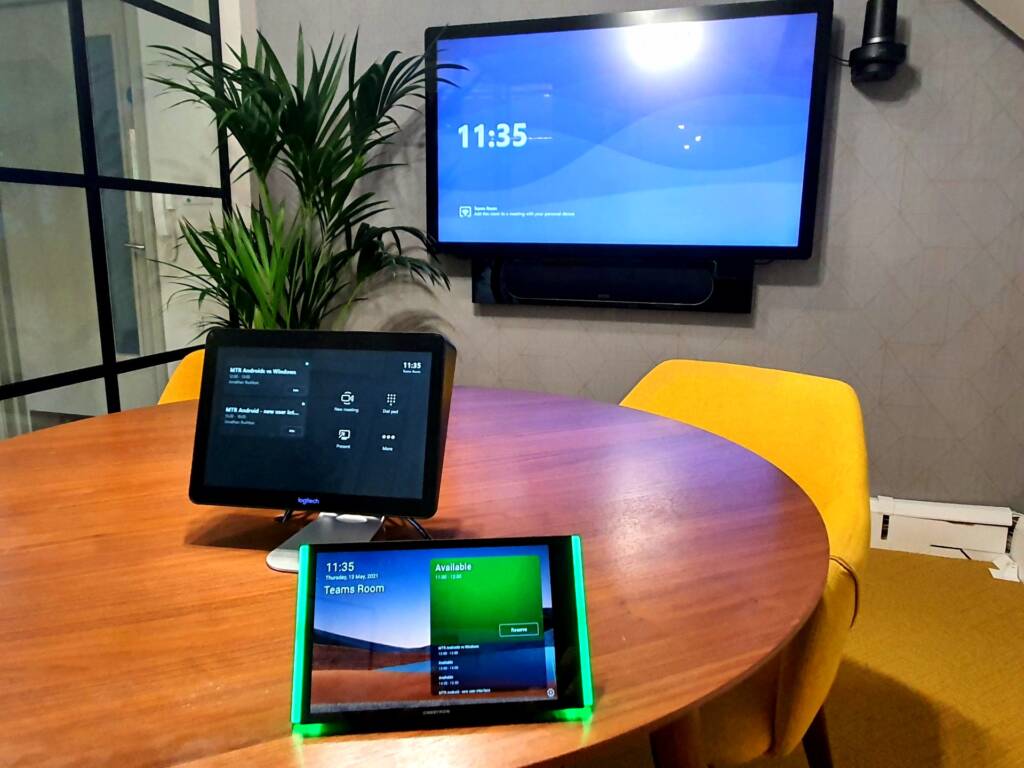Co-ordinated meetings
1plex recently upgraded our Microsoft Teams Room device (MTR) and generation 1 Surface hub to support co-ordinated meetings and have spent a couple of weeks testing the solution, here are some initial thoughts.

At 1plex we are increasingly working with customers who are jumping on the MTR bandwagon and are beginning to see the solution emerge as the default choice in video enabled meeting rooms. Customers enjoy the ease of use and we see high adoption rates with features such as proximity join proving popular as companies look to make meeting rooms simpler with less touch points. A typical meeting room now features an MTR, often combined with a camera/audio all in one solution such as the Poly Studio.
Some of these customers also have investments in Surface Hub which were purchased for their rich collaboration, pen and ink capabilities rather than solely used as video conference devices.
The new strategy from Microsoft see’s these two devices work together in a single meeting room, MTR providing the video conference capability and Surfacehub providing the rich collaboration experience. Configuration of the devices is relatively simple assuming both are on the latest (August 2020) versions of the software.
Typically, in a meeting room the MTR will be the fixed single or dual screen in the room, the surface hub, especially if a Hub 2S will often be free standing presented on a mobile trolley.
So having used the system for the last couple of weeks, here’s some feedback:
Meeting join
Starting a co-ordinated meeting could not be easier, both devices support proximity join so meetings can be started from a Laptop (or tablet/phone) running Microsoft Teams, simply join a meeting from your device and if you are in Bluetooth range of the system you will be presented with an option to join from the room device detected nearby. Alternatively start the meeting on the touch screen of the MTR, either way the MTR will join the meeting and Surface hub will also immediately join. Starting a co-ordinated meeting really couldn’t be easier.
Meeting experience
Once the meeting has started, remote video will be shown on the MTR, the camera and audio connected to the MTR will be used to send video to remote attendees. There are options that can be configured on the Surfacehub but the default configuration means the Hub joins the call with its camera off and microphone muted.
The whiteboard on the SurfaceHub can be used and shared in the Teams call, by default this will be seen by any remote participants who will continue to receive a video and audio feed from the MTR. The MTR in the room is clever enough to know that the whiteboard is being sent from the Surface hub so it keeps the video feed fixed on remote participants. This is the solution working at its best, the excellent collaborative features of the MS whiteboard on the surfacehub whilst MTR shows remote attendee video provides a great communication and collaboration experience.
Other collaborative applications installed on the Surfacehub can also be shared – this is where it can get a little confusing. The MTR is intelligent enough to know that its role in a co-ordinated meeting is to display remote attendees’ video and it does this brilliantly with the Whiteboard. When another collaboration app is shared on the Surfacehub, the MTR treats it as any other shared content and displays it on the main screen. On a single screen MTR this means you have no view of the remote participants video. A two screen MTR solves this problem and retains the remote video view by showing the content on the second screen.
(One question we received is whether a single mobile SurfaceHub could be wheeled between MTR equipped meeting rooms to convert the room to rich video/collaboration room on demand. Technically the answer to this is yes but both MTR and Surfacehub would need to be reconfigured to pair with each other so this would require technical intervention so not something we would recommend)
Summary
First off the co-ordinated meeting join process is brilliant, requires no thought at all, it simply works.
The simplicity of using MTR and Surfacehub in co-ordinated meetings makes the solution very accessible and for dual screen MTR installations, Surfacehub is a perfect collaboration companion. However, the most common MTR solutions we support are single screen solutions and the meeting experience is compromised when remote video of remote participants disappears when non whiteboard content Is shared. Whether this is addressed in a future release will be interesting to see as its potentially holding back what is otherwise a great solution.